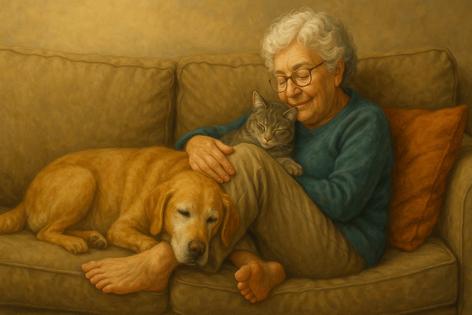Senior Companions: Caring for Aging Cats and Dogs
Published in Cats & Dogs News
The signs of age arrive quietly. A dog that once bounded up the stairs now takes them with caution. A cat that spent nights leaping from bookshelves prefers a warm spot on the floor. As veterinary care improves and pets live longer than ever before, owners are facing a new challenge: how to keep aging cats and dogs comfortable, healthy and part of the family’s daily life.
Longer Lives, New Challenges
Decades ago, a 10-year-old dog was considered old, and a 12-year-old cat rare. Today, advances in medicine, nutrition and preventive care mean many pets live well into their teens. That longevity brings new responsibilities for owners, veterinarians say. Senior pets face the same range of chronic conditions seen in people: arthritis, diabetes, heart disease, kidney decline and cognitive changes. While these diagnoses can be daunting, proactive care and environmental adjustments can dramatically improve quality of life.
The Importance of Veterinary Checkups
Experts recommend more frequent vet visits as pets enter their senior years—often every six months. Routine blood work, dental checks and screenings for organ function allow veterinarians to catch problems before they advance. Subtle shifts, such as weight loss or increased thirst, can signal underlying disease. “We can’t expect animals to tell us what hurts, so it’s our job to look for the clues,” said Dr. Melissa Turner, a small-animal veterinarian in Chicago. Regular monitoring gives pet owners a chance to respond with medication, diet changes or lifestyle adjustments that may extend a pet’s comfort and lifespan.
Diet and Weight Management
Nutrition plays a central role in aging. Senior-specific diets are formulated to maintain muscle mass, support joint health and provide appropriate calorie levels. Weight management becomes especially critical. Overweight pets are at greater risk for arthritis and diabetes, while underweight pets may be showing signs of more serious disease. Providing easily digestible food, sometimes with added supplements like omega-3 fatty acids or glucosamine, can help address both mobility and inflammation issues. Owners should consult their veterinarian before making any changes, as the nutritional needs of senior cats and dogs vary widely.
Keeping Them Moving
Exercise remains vital, but it must be tailored to an older body. Dogs may benefit from shorter, more frequent walks rather than long runs, while cats often respond well to gentle play sessions that encourage stretching and mobility. Pet-friendly ramps and stairs can help animals navigate couches and beds without strain. For dogs, swimming or hydrotherapy is increasingly popular as a low-impact way to maintain muscle tone. For cats, climbing structures with multiple levels at modest heights give them outlets for natural behaviors without the risk of high jumps.
Comfort at Home
Small changes in the home can ease everyday life. Orthopedic beds, non-slip rugs and heated pads provide comfort for stiff joints. Elevated food and water bowls reduce strain on the neck and back. Litter boxes with low sides accommodate cats with arthritis. Quiet corners allow senior pets to rest away from household commotion, while still keeping them connected to family life. These adjustments, while simple, can make the difference between a pet struggling in silence and one who remains active and engaged.
Cognitive and Emotional Care
Like humans, animals can experience cognitive decline, sometimes called “canine cognitive dysfunction” in dogs. Symptoms include disorientation, disrupted sleep cycles and changes in interaction. Providing mental stimulation—puzzle feeders, new scents on walks, gentle training sessions—helps keep aging minds active. Equally important is emotional care. Older pets may seek more companionship, relying on their owners’ presence for reassurance. Maintaining routines and offering gentle affection reinforce a sense of stability.
Saying Goodbye, With Love
Despite the best care, every pet’s journey eventually reaches its end. For many owners, this stage is the most difficult, as they balance their desire to hold on with their duty to prevent suffering. Veterinarians can help guide families through hospice care and, when the time comes, humane euthanasia. “The gift of a peaceful passing is one of the hardest but most loving decisions we make,” Turner said. “It’s the final act of care.”
Aging as a Shared Experience
For those who have walked the path of senior pet care, the experience is as rewarding as it is challenging. Older animals often develop a deepened bond with their owners, becoming quieter companions who seek comfort in presence rather than play. Caring for them through their final years becomes less about extending time and more about enriching it. Whether through an extra-soft blanket, a slow walk in the park or simply sitting side by side, those moments carry meaning.
As cats and dogs live longer, the responsibilities of their owners expand. But in the slowing steps of a faithful dog or the gentle purr of a senior cat, many find a reminder of the loyalty and love that first made them part of the family.
========
This article was created, in part, utilizing AI tools.









Comments